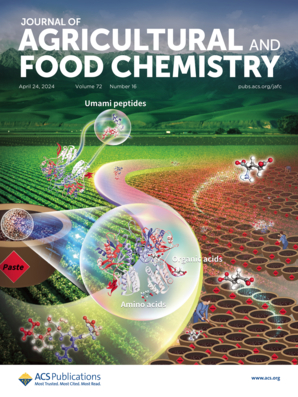Metabacillus sp. JX24中转化除草剂Mesotrione的新型硝基还原酶的鉴定与表征
IF 5.7
1区 农林科学
Q1 AGRICULTURE, MULTIDISCIPLINARY
引用次数: 0
摘要
美索三酮是一种常用的4-羟基苯基丙酮酸双加氧酶(HPPD)抑制剂除草剂,对农业生态系统的可持续性和非目标生物造成威胁。微生物在美索三合一的生物降解中起着重要作用。然而,对参与中三酮降解的分子机制的理解仍然相当有限。本文分离到了一株能降解中三酮的Metabacillus sp. JX24菌株。该菌株在12 h内可有效降解约98%的100 μM的中三酮。结果表明,中三酮是通过连续还原硝基生成2-氨基-4-甲基磺酰基苯甲酸(AMBA)来降解的。从菌株JX24中克隆出一种编码新型硝基还原酶mnrA的基因,该基因负责中三酮的转化。MnrA与报道的中三酮硝基还原酶具有低序列同源性(<20%)。纯化后的MnrA在体外以NADH或NADPH为辅助因子催化中三酮的硝基还原。中三酮的MnrA Km和kcat/Km值分别为22.0 μM和0.57 μM - 1 min-1。解毒实验表明,MnrA介导的中三酮还原产物AMBA不抑制HPPD活性,表明MnrA对中三酮具有解毒作用。我们的工作为消除环境中的中三酮残留提供了一种新的酶资源。本文章由计算机程序翻译,如有差异,请以英文原文为准。

Identification and Characterization of a Novel Nitroreductase Transforming the Herbicide Mesotrione in Metabacillus sp. JX24
Mesotrione, a commonly used 4-hydroxyphenylpyruvate dioxygenase (HPPD) inhibitor herbicide, threatens agro-ecosystem sustainability and nontarget organisms. Microbes play a significant role in the biodegradation of mesotrione. However, an understanding of the molecular mechanisms involved in mesotrione degradation is still quite limited. Here, a bacterial strain Metabacillus sp. JX24 capable of degrading mesotrione was isolated. The strain could effectively degrade about 98% of 100 μM mesotrione within 12 h. It was revealed that mesotrione was degraded through successive reduction of its nitro group to generate 2-amino-4-methylsulfonylbenzoic acid (AMBA). A gene, mnrA, encoding a novel nitroreductase MnrA responsible for the transformation of mesotrione, was cloned from strain JX24. MnrA shared low sequence identities (<20%) with the reported mesotrione nitroreductases. The purified MnrA catalyzed the nitro reduction of mesotrione with NADH or NADPH as cofactors in vitro. The Km and kcat/Km values of MnrA for mesotrione were 22.0 μM and 0.57 μM–1 min–1, respectively. The detoxification assay indicated that AMBA, the product of MnrA-mediated mesotrione reduction, did not inhibit HPPD activity, suggesting that MnrA confers a detoxifying action on mesotrione. Our work provides a novel enzymatic resource for the elimination of mesotrione residues in the environment.
求助全文
通过发布文献求助,成功后即可免费获取论文全文。
去求助
来源期刊
CiteScore
9.90
自引率
8.20%
发文量
1375
审稿时长
2.3 months
期刊介绍:
The Journal of Agricultural and Food Chemistry publishes high-quality, cutting edge original research representing complete studies and research advances dealing with the chemistry and biochemistry of agriculture and food. The Journal also encourages papers with chemistry and/or biochemistry as a major component combined with biological/sensory/nutritional/toxicological evaluation related to agriculture and/or food.

 求助内容:
求助内容: 应助结果提醒方式:
应助结果提醒方式:


